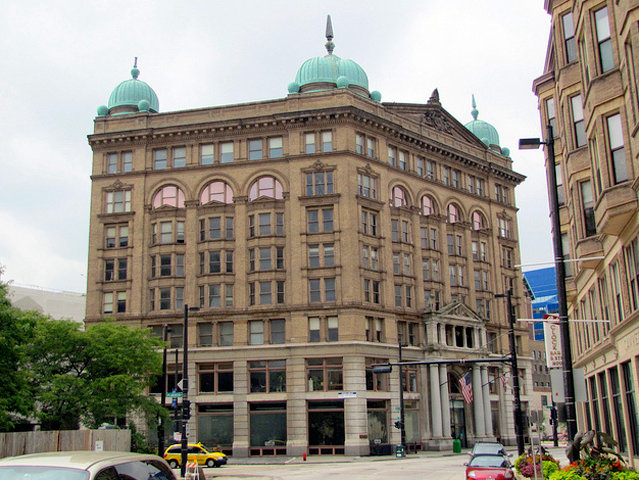As much as Milwaukeeans treasure some of the city's landmarks, few of us know much about the folks who created them.
Architect Henry Koch designed City Hall – once America's tallest building – Turner Hall, The Pfister and other great Brew City buildings. But does anyone – beyond a small cadre of architecture students and geeks – know his name?
Even less known are Koch disciples Herman Schnetzky and Eugene Liebert, two German immigrants, who, like Koch, arrived in Milwaukee and stayed to ply their trade. All their best-known work was executed in the then-fashionable Romanesque Revival style.
Schnetzky was born in Wriezen, Germany, in 1850 and arrived in Milwaukee 18 years later. By 1869 he was working as a draftsman for architect George Mygatt – who, it has been suggested, was the first professional architect in Milwaukee – and his apprentice Henry Koch.
Koch left to to create a firm in partnership with Julius Hess a year later and it is presumed that Schnetzky followed. But soon Koch was on his own and it was during these years that Schnetzky helped Koch design many early Milwaukee public schools. Soon, Schnetzky was doing that kind of work, and other more prestigious commissions on his own.
In 1887, Schnetzky designed Greenfield School in West Allis. It was later renamed Garfield School and is currently home to the West Allis Historical Society. The Romanesque Revival schoolhouse was added to the National Register of Historic Places in 2006.
Around the same time he drew Fifth Street School and riffed on it to create a smaller version for Walnut Street School (now lost).
He also designed St. Martini Lutheran Church, 1520 S. 16th St., the same year, St. John's Lutheran Church, 804 W. Vliet St., two years later, and in 1890, Blatz Brewing Company Office, 1120 N. Broadway, and the McGeoch Building, 322 E. Michigan St. All of these are still standing.
In 1892, he went into partnership with his former Koch colleague, Eugene Liebert.
Liebert was born in Berlin in 1866 and came to Milwaukee in 1883. His mother was a Gallun – as in the Trostel and Gallun Tannery Galluns of Milwaukee – and he worked at the tannery until a partner there found him a job in Koch's office.
Liebert joined Schnetzky as a draftsman in 1887 and they officially joined forces five years later. That same year, they built St. Michael's Church, 1445 N. 24th St., and the following year, St. Stephen Lutheran School in Walker's Point (which still stands, but is vacant) and a major addition to Maryland Avenue School.
But it was in 1896 that the duo drew the most enduring symbol of their legacy in Milwaukee: the Germania Building, 135 W. Wells St. That same year they produced plans for a new West Side (later West Division) High School.
In 1897, Schnetzky and Liebert parted ways, and each continued to build in Milwaukee. In 1900, the latter purchased land on the east bank of the Milwaukee River and built three distinctive summer homes and a lovely chalet-style barn.
All still stand on Sunny Point Lane, though they are among 16 homes that the City of Glendale is trying to buy and raze.
Schnetzky died in 1916 and his son Hugo continued the family practice. Liebert died in 1945 in the home he designed and built for himself in 1887 at 1948 N. Holton St.
According to Liebert's great-grandson, the family has made something of a tradition of Eugene's profession.
"He had four sons, two were architects – Walter and Carl – and the other two were engineers, including my grandfather, Arthur," says Rochester, N.Y.-based architect Todd Liebert.
"I am the only architect since Walter and Carl, with a practice that includes hospitals, schools and municipal buildings in both New York and North Carolina."
For a nice overview of Liebert's residential, commercial and ecclesiastical work, check out Milwaukee architectural historian H. Russell Zimmermann's book, "The Architecture of Eugene Liebert."
You might be surprised how many of his works are still here, brightening up our landscape today.
Born in Brooklyn, N.Y., where he lived until he was 17, Bobby received his BA-Mass Communications from UWM in 1989 and has lived in Walker's Point, Bay View, Enderis Park, South Milwaukee and on the East Side.
He has published three non-fiction books in Italy – including one about an event in Milwaukee history, which was published in the U.S. in autumn 2010. Four more books, all about Milwaukee, have been published by The History Press.
With his most recent band, The Yell Leaders, Bobby released four LPs and had a songs featured in episodes of TV's "Party of Five" and "Dawson's Creek," and films in Japan, South America and the U.S. The Yell Leaders were named the best unsigned band in their region by VH-1 as part of its Rock Across America 1998 Tour. Most recently, the band contributed tracks to a UK vinyl/CD tribute to the Redskins and collaborated on a track with Italian novelist Enrico Remmert.
He's produced three installments of the "OMCD" series of local music compilations for OnMilwaukee.com and in 2007 produced a CD of Italian music and poetry.
In 2005, he was awarded the City of Asti's (Italy) Journalism Prize for his work focusing on that area. He has also won awards from the Milwaukee Press Club.
He has be heard on 88Nine Radio Milwaukee talking about his "Urban Spelunking" series of stories, in that station's most popular podcast.




%20copy.jpg)


